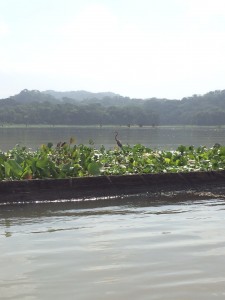There are many fun things to do in Gamboa, Panama and among those opportunities is the kayaking trip around Gatun Lake that our group took this morning. Gatun Lake is created by the damming of the Chagres River which was first done in 1912 (“Gatun Lake”). This three and a half trip around the lake presented itself with some interesting information and difficulties.
El Nino is a climatology phenomenon that happens every couple of years and effects parts of Central and South America. It is characterized by unusually warm conditions in the oceans along the tropics and mixtures of heavy rain in some areas and dry seasons in others (“El Nino”). In Panama, El Nino has caused a dry season that is much dryer than usual and many lakes and rivers have significantly lower levels of water. This was illustrated yesterday when we took a canoe trip to the Village of Embera but also today in the kayaks. When looking around the lake you can see tree trunks sticking a couple feet out of the water. Gatun Lake is a manmade lake so it is expected that there would be trees on the bottom but our guide, Ian, was telling us that usually the trees are covered up buy the rainfall but because of El Nino, they remain uncovered. The main problem with this was boats and kayaks running into them but Ian also expressed the concern of getting to close to these trees that could have bee and wasp nests since they have been exposed and dry for so long.

On the far left of this picture and off in the distance you can see the tree stumps protruding from the water.
If you look around the lake you can see tons of greenery that looks like clumps of lily pads speckled with purple flowers; these would be the water hyacinths. Hyacinths are an invasive species in Gatun Lake meaning they aren’t native to the area and have caused more harm than good (“Eichhornia Crassipes”). Our guide, Ian, pointed out that the plants tend to clog up water ways because they grow in such mass numbers. The hyacinths also litter the lake. When you look out at the lake you can see the massive number of these invasive plants just in one cove. It was quite evident how abundant they are when we were paddling through the hyacinths and other vegetation.

In this picture you can see the invasive water hyacinths as well as a heron relaxing among the vegetation`1.
As well as a lot of greenery, we also saw a variety of bird like young blue herons and an anhinga. The shorebirds called Northern Jacana are another species of bird that were prominent on the lake. These medium sized, dark brown birds can be identified by their yellow patches under their wings that are visible when they fly. These birds are very vocal, flying around the lake and they are light enough that they can sit on the patches of water hyacinth. These birds’ mating patterns are very interesting. Each female can have up to four mates and they will lay eggs with each male but leave them to take care of the incubation and young (“Northern Jacana”). I found this very interesting because this doesn’t happen too often in nature.
It is difficult to see a good amount of diverse animals and birds while kayaking because it isn’t always the most graceful or quiet process. However, this gave us a great opportunity to learn about water vegetation. Even though the curse caused me to temporarily lose a shoe in the lake, the kayaking trip around Gatun Lake was a fun and educational experience!
References:
“Eichhornia Crassipes”. UF Center for Aquatic and Invasive Plants”. University of Florida, 2015. Web. 21 May 2016.
“El Nino”. Encyclopædia Britannica. Encyclopædia Britannica Online. Encyclopædia Britannica Inc., 2016. Web. 21 May. 2016
“Gatun Lake”. Encyclopædia Britannica. Encyclopædia Britannica Online. Encyclopædia Britannica Inc., 2016. Web. 21 May. 2016
“Northern Jacana” Guide to North American Birds. Audubon, 2014. Web. 21 May 2016.


